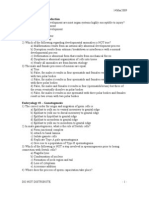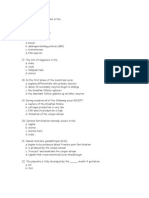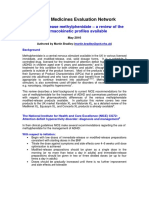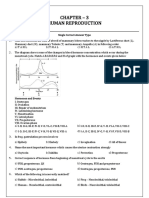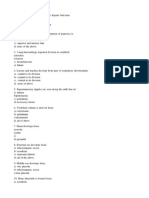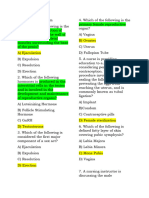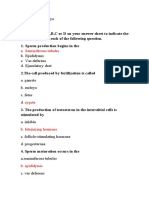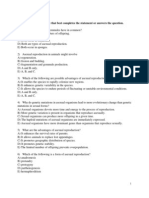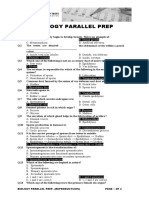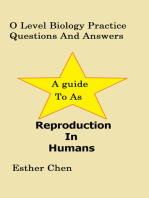0 ratings0% found this document useful (0 votes)
9 viewsRepro Quiz
Repro Quiz
Uploaded by
violy villegas1. Sperm cells develop in the seminiferous tubules of the testes.
2. The leftover portion of the process vaginalis that covers the testes is the tunica vaginalis.
3. Large cells that nourish developing sperm cells and form the blood-testes barrier are Sertoli cells.
Copyright:
© All Rights Reserved
Available Formats
Download as DOCX, PDF, TXT or read online from Scribd
Repro Quiz
Repro Quiz
Uploaded by
violy villegas0 ratings0% found this document useful (0 votes)
9 views1 page1. Sperm cells develop in the seminiferous tubules of the testes.
2. The leftover portion of the process vaginalis that covers the testes is the tunica vaginalis.
3. Large cells that nourish developing sperm cells and form the blood-testes barrier are Sertoli cells.
Original Title
REPRO QUIZ
Copyright
© © All Rights Reserved
Available Formats
DOCX, PDF, TXT or read online from Scribd
Share this document
Did you find this document useful?
Is this content inappropriate?
1. Sperm cells develop in the seminiferous tubules of the testes.
2. The leftover portion of the process vaginalis that covers the testes is the tunica vaginalis.
3. Large cells that nourish developing sperm cells and form the blood-testes barrier are Sertoli cells.
Copyright:
© All Rights Reserved
Available Formats
Download as DOCX, PDF, TXT or read online from Scribd
Download as docx, pdf, or txt
0 ratings0% found this document useful (0 votes)
9 views1 pageRepro Quiz
Repro Quiz
Uploaded by
violy villegas1. Sperm cells develop in the seminiferous tubules of the testes.
2. The leftover portion of the process vaginalis that covers the testes is the tunica vaginalis.
3. Large cells that nourish developing sperm cells and form the blood-testes barrier are Sertoli cells.
Copyright:
© All Rights Reserved
Available Formats
Download as DOCX, PDF, TXT or read online from Scribd
Download as docx, pdf, or txt
You are on page 1of 1
QUIZ ON REPRODUCTIVE SYSTEM, GAMETOGENESIS AND O-M CYCLES
1. Which of the following region in the testis do sperm cells
develop? 14. The funnel-shaped end of the uterine tube (fallopian tube) is
A) efferent ductules. the
B) interstitial cells (Leydig cells). A) ampulla. C) infundibulum.
C) seminiferous tubules. B) fimbriae. D) serosa.
D) tunica albuginea. 15. The innermost layer of the uterus is the
2. The leftover portion of the process vaginalis that covers the A) endometrium. C) perimetrium.
testes is the B) myometrium. D) tunica albuginea
A) inguinal canal. C) tunica albuginea 16. Which of these layers is shed during menses?
B) tunica vaginalis. D) tunica media.. A) perimetrium
3. Large cells that nourish developing sperm cells and form the B) basal layer of endometrium
blood-testes barrier are C) functional layer of endometrium
A) spermatocytes. C) Leydig cells D) both b and c
B) Sertoli cells. D) sperm cells. 17. The first episode of menstrual bleeding is called
A) PMS. C) menopause.
Given these cells: B) menarche. D) amenorrhea.
1. primary spermatocytes 18. Which of these events is NOT correctly matched with the time
2. secondary spermatocytes when it occurs?
3. Spermatids A) beginning of menses - day 1
4. Spermatogonia B) ovulation - day 14
5. sperm cells. C) LH surge - day 21
4. Arrange the cells in the order in which they are produced D) corpus luteum formed - days 14-26
during spermatogenesis. 19. The hormone responsible for ovulation is
A) 1,2,3,4,5 C) 3,1,2,4,5 A) FSH. C) GnRH.
B) 2,1,3,5,4 D) 4,1,2,3,5 B) HCG. D) LH.
5. From each primary spermatocyte, __________ sperm cell(s) is 20. In the menstrual cycle, progesterone levels are highest during
(are) produced; from each primary oocyte, __________ A) the proliferative phase.
secondary oocyte(s) is (are) produced. B) menses.
A) 1, 2 C) 2, 2 C) the secretory phase.
B) 1, 4 D) 4, 1 D) ovulation
6. A comma-shaped structure on the posterior testis; maturation 21. The cause of menses in the menstrual cycle is
of sperm cells occurs here: A) increased progesterone production from the ovary,
A) prostatic urethra C) ductus deferens which produces blood clotting.
B) epididymis D) ejaculatory duct B) increased estrogen secretion from the ovary, which
7. The cap (formed from the corpus spongiosum) over the distal stimulates the muscles of the uterus to contract.
end of the penis is the C) decreased progesterone and estrogen secretion by the
A) bulb of the penis. ovary.
B) root of the penis. D) decreased production of oxytocin, causing the muscles
C) prepuce (foreskin). of the uterus to relax.
D) glans. 22. A woman with a typical 28-day menstrual cycle is most likely
8. Erectile columns that form the dorsal surface and sides of the to become pregnant from sexual intercourse occurring on days
penis are the A) 1-5. C) 9-14.
A) corpus spongiosum. B) 5-16. D) 14-20.
B) corpora cavernosa. 23. Which of the following is NOT belong to the group?
C) glans penis. A) voice changes
D) root of the penis. B) increase in muscle mass
9. This hormone is released from the hypothalamus and C) widening of shoulders
stimulates cells in the anterior pituitary. D) oogonia arrested on Prophase 1
A) FSH C) GnRH 24. What do you call to the collection of external organs of female
B) LH D) testosterone reproductive system?
10. Testosterone has a negative-feedback effect on A) vulva C) uterus
A) GnRH secretion. C) LH secretion. B) vagina D) labia
B) FSH secretion. D) all of the above 25. How many egg cells will be produced in a female’s life time?
11. At birth, a girl has in her ovaries many __________ that have A) 100
started meiosis but stopped at prophase I. B) 1000
A) primary oocytes C) ova C) 400
B) 2nd oocytes D) oogonia D) Cannot be determined
12. A primary oocyte divides to produce a(n)
A) oogonium. C) polar body.
B) 2nd oocyte D) both b and c
13. During ovulation, a(n) __________ is released from the ovary.
A) oogonium C) secondary oocyte
B) primary oocyte D) polar body
You might also like
- Quiz EmbryologyDocument41 pagesQuiz EmbryologyMedShare90% (69)
- PediculosisDocument3 pagesPediculosisDarkCeades60% (5)
- Rational Functions On Medicine 2Document5 pagesRational Functions On Medicine 2Angie GonzalezNo ratings yet
- Draft Exam01Document13 pagesDraft Exam01Hannah Pegalan AlegarmeNo ratings yet
- Embryo ExamDocument28 pagesEmbryo Exammoha100% (2)
- O Level Biology Practice Questions And Answers: Heredity And Molecular GeneticsFrom EverandO Level Biology Practice Questions And Answers: Heredity And Molecular GeneticsNo ratings yet
- Scientific Discussion - En.idDocument9 pagesScientific Discussion - En.idassajadda lizikriNo ratings yet
- HUMAN REPRODUCTION-1 Madhu - QuestionDocument69 pagesHUMAN REPRODUCTION-1 Madhu - QuestionAyan Sarkar100% (1)
- Human ReproductionDocument107 pagesHuman ReproductionYashNo ratings yet
- D) Seminal Vesicle: C) EpididymisDocument3 pagesD) Seminal Vesicle: C) EpididymisEfanPutraNo ratings yet
- Human ReproducationDocument4 pagesHuman Reproducationmohammed asifNo ratings yet
- Quiz 4 A and P 2Document8 pagesQuiz 4 A and P 2Agartha HenewaaNo ratings yet
- Human Reproduction 51Document6 pagesHuman Reproduction 51upadhayaya556No ratings yet
- Embryo QuestionsDocument15 pagesEmbryo QuestionsSalmonella TyphiNo ratings yet
- Anatomy Exam Embryology With AnswersDocument13 pagesAnatomy Exam Embryology With Answersrk4876001No ratings yet
- Embryo QBDocument45 pagesEmbryo QBKerim SabicNo ratings yet
- Human Reproduction Udaan DPPDocument15 pagesHuman Reproduction Udaan DPPxxjksvddukebNo ratings yet
- Reproduction Unit DPPDocument10 pagesReproduction Unit DPPkumardheeraj93570No ratings yet
- Anaphy ReviewerDocument10 pagesAnaphy Reviewer8rvgjxf92kNo ratings yet
- Test-15 ReproductionDocument4 pagesTest-15 Reproductionarehmanmalik619No ratings yet
- MCQ On Human ReproductionDocument16 pagesMCQ On Human ReproductionKartik Gaming 2.0100% (1)
- Inter Test 5Document10 pagesInter Test 5wbk22222No ratings yet
- Human ReproductionDocument15 pagesHuman ReproductionkarthibaashokNo ratings yet
- OB QuizDocument45 pagesOB QuizJonas Marvin AnaqueNo ratings yet
- Reproductive HealthDocument103 pagesReproductive HealthShaibu HamNo ratings yet
- General Embryology Questions: Husain MohammadDocument25 pagesGeneral Embryology Questions: Husain MohammadMoiez AhmadNo ratings yet
- Human Reproduction Question BankDocument23 pagesHuman Reproduction Question Bankkaustubhchoudhary2005No ratings yet
- Embryology TBDocument38 pagesEmbryology TBKarl Delgado100% (2)
- EmbryologyDocument29 pagesEmbryologySara Gblabi50% (2)
- Med 1104 EmbryologyDocument12 pagesMed 1104 EmbryologyLe Shana ValentineNo ratings yet
- Wa0002.Document21 pagesWa0002.Deepak E deepakNo ratings yet
- Mdcat Bio W 4Document9 pagesMdcat Bio W 4Benzeen AromaticNo ratings yet
- HNS B103 Exam 2019Document4 pagesHNS B103 Exam 2019dobunga06No ratings yet
- Nand Foundation Academy, Shegaon. 9834274427: Xii - A DivDocument14 pagesNand Foundation Academy, Shegaon. 9834274427: Xii - A DivSanket PatilNo ratings yet
- Assignment Class-12 Subject:Bio - Zoology Unit 1: Chapter 2. Human ReproductionDocument6 pagesAssignment Class-12 Subject:Bio - Zoology Unit 1: Chapter 2. Human ReproductionjohnsonNo ratings yet
- BIOLOGY, PT1 QuestionsDocument8 pagesBIOLOGY, PT1 QuestionsAbhishek ratnooNo ratings yet
- ReproductionDocument9 pagesReproductionFatima AhmadNo ratings yet
- 2.human ReproductionDocument5 pages2.human ReproductionexercisestartNo ratings yet
- Periodical Science 5Document4 pagesPeriodical Science 5preciousfv14No ratings yet
- Practice Sheet How Do Organisms ReproduceDocument3 pagesPractice Sheet How Do Organisms ReproduceKanishka ChauhanNo ratings yet
- The Finale: Multiple Choice: Anatomy & Physiology Coloring WorkbookDocument3 pagesThe Finale: Multiple Choice: Anatomy & Physiology Coloring WorkbookJonash Morales0% (1)
- LESSON (5) Reproduction in HumanDocument13 pagesLESSON (5) Reproduction in Humanyasso4212000No ratings yet
- Questions Reproductive System1Document3 pagesQuestions Reproductive System1TakwaNo ratings yet
- Pre - Test in Female and Male AnatomyDocument4 pagesPre - Test in Female and Male AnatomyDaniel Barcena Lao-atenNo ratings yet
- Test Bank EmbryologyDocument33 pagesTest Bank EmbryologyLe Shana Valentine100% (1)
- Reproductive System TestDocument12 pagesReproductive System TestVân vui vẻ100% (1)
- Quiz ReproductiveDocument78 pagesQuiz ReproductiveMedShare88% (8)
- ReproductionDocument17 pagesReproductionkaran79No ratings yet
- 10th Foundation Biology Assignment - 06Document6 pages10th Foundation Biology Assignment - 06dheerajNo ratings yet
- Class - XII - Biology 2Document9 pagesClass - XII - Biology 2Rajesh Kumar ParidaNo ratings yet
- Test # 5 (Reproduction)Document3 pagesTest # 5 (Reproduction)Ahmad SaleemNo ratings yet
- CTS-3 STARS Academy Multan Campus-Secure PDFDocument14 pagesCTS-3 STARS Academy Multan Campus-Secure PDFHanzala ShahidNo ratings yet
- ReproductionDocument5 pagesReproductionhemant joshiNo ratings yet
- Embryology (1) MCQsDocument5 pagesEmbryology (1) MCQszydallsasmh45No ratings yet
- Genbio TestDocument11 pagesGenbio TestkatrinepajaroNo ratings yet
- 3rd Quarter Exam Science 10Document5 pages3rd Quarter Exam Science 10ROMELYN GRACE BORBENo ratings yet
- Direction: Encircle The LETTER of The Best Answer. Write The Chosen Letter On A Separate Sheet of PaperDocument4 pagesDirection: Encircle The LETTER of The Best Answer. Write The Chosen Letter On A Separate Sheet of PaperWendy LabastillaNo ratings yet
- Worksheet - Preparation For An Entry TestDocument3 pagesWorksheet - Preparation For An Entry TestAnika HinkovaNo ratings yet
- Anatomy 102 Practice Exam #3Document13 pagesAnatomy 102 Practice Exam #3lhayes123467% (6)
- O Level Biology Practice Questions And Answers: Reproduction In HumansFrom EverandO Level Biology Practice Questions And Answers: Reproduction In HumansRating: 2 out of 5 stars2/5 (2)
- The CervixFrom EverandThe CervixJoseph JordanNo ratings yet
- A History of Bodies, Brains, and Minds: The Evolution of Life and ConsciousnessFrom EverandA History of Bodies, Brains, and Minds: The Evolution of Life and ConsciousnessNo ratings yet
- UNIT PLAN Science 10 2nd GDocument14 pagesUNIT PLAN Science 10 2nd Gvioly villegasNo ratings yet
- UNIT PLAN Science 10 1st GDocument9 pagesUNIT PLAN Science 10 1st Gvioly villegasNo ratings yet
- Fastrack BiomoleculesDocument20 pagesFastrack Biomoleculesvioly villegasNo ratings yet
- LC3 RDDocument8 pagesLC3 RDvioly villegasNo ratings yet
- Chapter 2 Lesson 2 Ethics and Critical ThinkingDocument16 pagesChapter 2 Lesson 2 Ethics and Critical ThinkingSophia GraziellaNo ratings yet
- Nursing Care Plan CVADocument6 pagesNursing Care Plan CVAessevyNo ratings yet
- OxytocinDocument1 pageOxytocinSubbie OutlierNo ratings yet
- LP in Science 12 (Basic First Aid)Document9 pagesLP in Science 12 (Basic First Aid)Alvin Cabanela100% (1)
- List of Office Bearers IAP-ALS Group 2019-20Document4 pagesList of Office Bearers IAP-ALS Group 2019-20Manoj KumarNo ratings yet
- Tabel Bantu Kode Icd 10 Bahasa Indonesia Editedxls PDFDocument230 pagesTabel Bantu Kode Icd 10 Bahasa Indonesia Editedxls PDFqoy8585No ratings yet
- Nsaids-Case 2: Kim Gello C. Latonio Benjamin Christeany. LagmanDocument17 pagesNsaids-Case 2: Kim Gello C. Latonio Benjamin Christeany. LagmanBenjie LagmanNo ratings yet
- Major Nutritional Deficiency DiseasesDocument33 pagesMajor Nutritional Deficiency DiseasesMayuri Vohra100% (2)
- Low Vision Aids: Visual Outcomes and Barriers in Children With Low VisionDocument4 pagesLow Vision Aids: Visual Outcomes and Barriers in Children With Low VisionshishichanNo ratings yet
- SSCDocument73 pagesSSCshreepriya singhaniaNo ratings yet
- Noninvasive VentilationDocument6 pagesNoninvasive VentilationEma MagfirahNo ratings yet
- Acid-Base Imbalance: By: Kristine Louise E. JavierDocument68 pagesAcid-Base Imbalance: By: Kristine Louise E. JavierKristine Louise JavierNo ratings yet
- Poison FORENSICDocument16 pagesPoison FORENSICA. SihabNo ratings yet
- Periodontal Complications of Prescription and Recreational DDocument12 pagesPeriodontal Complications of Prescription and Recreational DRuxandra MurariuNo ratings yet
- 1.conginital Cardiac DefectsDocument39 pages1.conginital Cardiac DefectsJõsëph Jåy MîthNo ratings yet
- Application of Orem TheoryDocument17 pagesApplication of Orem TheoryKit LaraNo ratings yet
- CeftazidimeDocument3 pagesCeftazidimemgbabyloveNo ratings yet
- 2019 - Bowel and Bladder Injury Repair and Follow-Up After Gynecologic Surgery - 00006250-201902000-00012Document10 pages2019 - Bowel and Bladder Injury Repair and Follow-Up After Gynecologic Surgery - 00006250-201902000-00012Polyana FloresNo ratings yet
- Polyarteritis NodosaDocument6 pagesPolyarteritis NodosaEkaNo ratings yet
- Final Report On PediatricDocument17 pagesFinal Report On PediatricJoshua MillzNo ratings yet
- Tsuyuki 2002Document7 pagesTsuyuki 2002Basilharbi HammadNo ratings yet
- Pain Management in Critically Ill Patient: Prof. Dr. Andi Husni Tanra, PHD, SP - An-Kic-KmnDocument42 pagesPain Management in Critically Ill Patient: Prof. Dr. Andi Husni Tanra, PHD, SP - An-Kic-KmnReza Prakosa Sedyatama100% (1)
- Introduction To Intensive CareDocument7 pagesIntroduction To Intensive Caredrnitinkaushik4931No ratings yet
- Neoadjuvant Treatment in Ovarian Cancer-New Perspectives, New Challenges. 2022Document14 pagesNeoadjuvant Treatment in Ovarian Cancer-New Perspectives, New Challenges. 2022Prodromos KoutoukoglouNo ratings yet
- Allergic Rhinitis: - Fortis Hospital MohaliDocument1 pageAllergic Rhinitis: - Fortis Hospital MohalipranavbhararaNo ratings yet
- Debridat CT 9409Document9 pagesDebridat CT 9409Mey KhNo ratings yet
- What Are Biomedical Interventions?: GeneticsDocument2 pagesWhat Are Biomedical Interventions?: GeneticsiedaNo ratings yet
